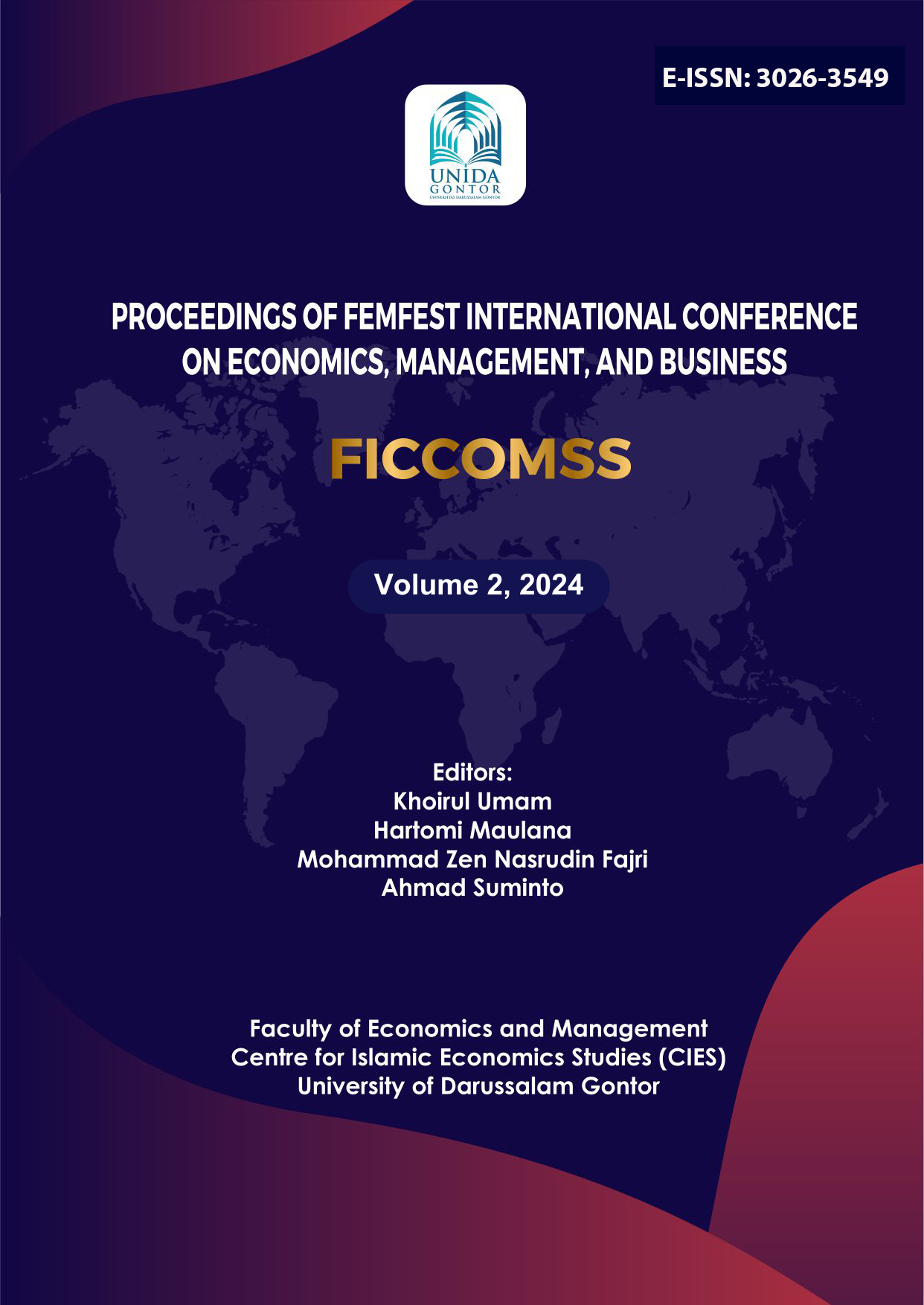A Conceptual Paper: Factors Affecting the Stability of Islamic Banking
Abstract
References
Abrar, T., Ahmed, F., & Kashif, M. (2018). Financial stability of Islamic versus conventional banks in Pakistan. Al-Iqtishad Journal of Islamic Economics, 10(2), 341–366.
Ahmad Fatoni. (2022). PENGARUH KEBIJAKAN RESTRUKTURISASI PEMBIAYAAN, UKURAN BANK, NON PERFORMING FINANCING, DAN PRODUK DOMESTIK BRUTO TERHADAP STABILITAS PERBANKAN SYARIAH DI INDONESIA: BUKTI EMPIRIS DI TENGAH PANDEMI COVID 19. Jurnal Ilmiah Ekonomi Dan Bisnis, 19(2), 140–148. https://doi.org/10.31849/jieb.v19i2.7124
Amidu, M., & Wolfe, S. (2013). Does bank competition and diversification lead to greater stability? Evidence from emerging markets. Review of Development Finance, 3(3), 152–166.
Azizah, A. N. (2023). Gulf Cooperation Council (GCC) sebagai Organisasi Antar-Pemerintah Regional di Kawasan Teluk Persia dalam Menangani Krisis Diplomasi Qatar-Arab Saudi. Journal of International Relations, 9(1), 189–208.
Dahlan, S. (2005). Manajemen Lembaga Keuangan Kebijakan Moneter dan Perbankan. Fakultas Ekonomi Universitas Indonesia.
Danlami, M. R., Abduh, M., & Abdul Razak, L. (2022). CAMELS, risk-sharing financing, institutional quality and stability of Islamic banks: evidence from 6 OIC countries. Journal of Islamic Accounting and Business Research, 13(8), 1155–1175. https://doi.org/10.1108/JIABR-08-2021-0227
Dutta, K. D., & Saha, M. (2021). Do competition and efficiency lead to bank stability? Evidence from Bangladesh. Future Business Journal, 7(1), 6. https://doi.org/10.1186/s43093-020-00047-4
Dwinanda, I. Z., & Sulistyowati, C. (2021). The Effect of Credit Risk and Liquidity Risk on Bank Stability. Jurnal Ilmu Ekonomi Terapan, 6(2), 255. https://doi.org/10.20473/jiet.v6i2.31144
Fajri, M. Z. N. (2022). The effect of Covid-19 and sectoral financing on Islamic Bank profitability in Indonesia. THE EFFECT OF COVID-19 AND SECTORAL FINANCING ON ISLAMIC BANK PROFITABILITY IN INDONESIA, 5(01), 38-60.
Karini, A., & Filianti, D. (2018). Analisis Perbandingan Kinerja Keuangan Bank Syariah di Indonesia, Malaysia, Brunei dan Thailand Periode 2011-2016. Jurnal Ekonomi Syariah Teori Dan Terapan, 5(10), 835–847.
Miah, M. D., & Uddin, H. (2017). Efficiency and stability: A comparative study between islamic and conventional banks in GCC countries. Future Business Journal, 3(2), 172–185.
Mufraini, M. A., Murodi, M., Wicaksono, A. T. S., Fauziah, F., & Mubarok, F. (2021). The efficiency of human resources management during the disruption and pandemic era: An empirical study of Indonesian Islamic Banks. The Journal of Asian Finance, Economics and Business, 8(6), 437–446.
Prastiwi, I. E. (2018). Analisis Kondisi Makro Ekonomi dan Likuiditas Terhadap Pembiayaan Bermasalah Perbankan Syariah. Sumber, 4, 28.
Rahmayuni, S., & Paminto, A. (2021). Corporate Governance and Macroeconomics on The Financial Stability of Islamic Banks. IJEBD (International Journal of Entrepreneurship and Business Development), 4(4), 510–515.
renda Gonzalez-Hermosillo, B. (1999). Developing indicators to provide early warnings of banking crises. From the Edito, 36.
Rusydiana, A. S. (2018). Efisiensi Dan Stabilitas Bank Umum Syariah Di Indonesia. Akuntabilitas, 11(2). https://doi.org/10.15408/akt.v11i2.7033
Saputri, P. L., Agriyanto, R., & Abdillah, M. (2020). Analyzing The Macroeconomic and Fundamental Determinants of Non-Performing Financing of Bank Muamalat Indonesia. Economica: Jurnal Ekonomi Islam, 11(1), 49–78. https://doi.org/10.21580/economica.2020.11.1.4346
Saputri, P. L., & Ahmadi, H. (2022). FINANCING DISTRIBUTION AND ITS EFFECT ON NON-PERFORMING FINANCING OF ISLAMIC BANKS. Jurnal Alwatzikhoebillah: Kajian Islam, Pendidikan, Ekonomi, Humaniora, 8(2), 96–106.
Saputri, P. L., Ahmadi, H., & Kusumawati, D. A. (2023). The Effect of Financing Distribution on NPF in Islamic Banking: A Short- and Long-Term ECM Analysis (pp. 197–208). https://doi.org/10.1007/978-3-031-27860-0_18
Schinazi. (2006). Preserving Financial Stability. International Monetary Fund.






